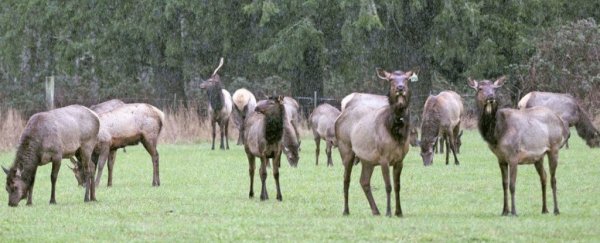If the elk of Yellowstone National Park had a spokeswoman, she would be working overtime trying to set the record straight about elk-human interactions: Despite the headlines, the average elk has a lot more to fear from the average human.
There are, after all, myriad websites with details on how to kill the mostly docile woodland creatures with arrows and guns, strip the muscle from their bones, or purchase literal buckets of their antlers. There are also parts of the Internet dedicated to sharing pictures of people posing with elk corpses.
But days at Yellowstone National Park have begun to resemble an episode of "When Animals Attack!"
Twice in three days, cow elk — females of the elk species — have attacked people at the popular national park, using strong legs and sharp hoofs to send unsuspecting humans to the hospital.
The reason for the sudden aggression: babies.
It is calving season at Yellowstone, and elk mothers are fiercely protective of their newborns, as two women learned too late.
On Sunday, Charlene Triplett, a 51-year-old who works at the Mammoth Hot Springs Hotel on park property, was attacked.
The elk was defending a calf that was roughly 20 feet away, hidden behind cars, park rangers say. It's unclear whether Triplett even saw the calf before she was approached by the elk.
"The elk reportedly reared up and kicked Ms. Triplett multiple times with its front legs, hitting her head, torso, and back," the National Park Service said in a statement Monday.
Triplett's injuries were severe, and she was flown to the trauma center at Eastern Idaho Regional Medical Center.
Park rangers meanwhile stayed in the area, warning other unsuspecting visitors about the elk and her calf. No one was cited, but the park warned people to stay 25 yards from the animals.
Apparently, not everyone got the word in time.
On Tuesday, Penny Allyson Behr, a 53-year-old from Cypress, Tex., was walking between two cabins "when she was surprised by an elk bedded along the cabin wall with a calf nearby," rangers said in a news release posted Wednesday.
And its approach wasn't just a threatening feint. The elk "pursued and struck her with its legs in the head and torso," the National Park Service said.
Park officials said they don't know whether the same elk and the same calf are involved in each case.
What is clear is that the elk, while mostly non-aggressive herbivores, are big, powerful and capable of inflicting damage.
There are as many as 20,000 elk in Yellowstone, which stretches over nearly 3,500 square miles. The animals live in six or seven herds. Males can be more than 700 pounds and eight feet long; females can be 500 pounds and nearly seven feet long.
And a quarter-ton of mother elk can be particularly aggressive in defense of their young, while males can become unpredictable, even hostile, during mating season, instances that make headlines and result in dramatic videos.

Those and other incidents share common threads.
The elk were mostly minding their own business; the people got too close.
2018 © The Washington Post
This article was originally published by The Washington Post.
